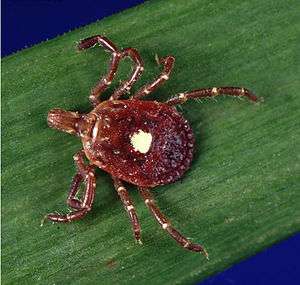Opilioacariformes
| Opilioacariformes Temporal range: Cenomanian–Recent | |
|---|---|
 | |
| Opilioacarus segmentatus | |
| Scientific classification | |
| Kingdom: | Animalia |
| Phylum: | Arthropoda |
| Subphylum: | Chelicerata |
| Class: | Arachnida |
| Subclass: | Acari |
| Order: | Opilioacariformes Johnston, 1968 |
| Family: | Opilioacaridae With, 1902 |
| Synonyms [1] | |
| |
Opilioacariformes is the smallest order (or superorder[2]) of mites, containing a single family, and around 10 genera.[3] They are rare, large mites, and are widely considered primitive, as they retain six pairs of eyes, and abdominal segmentation.[4] Opilioacariformes may be the sister group to the Parasitiformes.[5]
The first member of the Opilioacariformes to be discovered was the Algerian species Opilioacarus segmentatus, which was described by Carl Johannes With in 1902, followed by the Sicilian Eucarus italicus and Eucarus arabicus from Aden, both in 1904.[3] Two fossil specimens are known, one of which was discovered in Baltic amber from the Eocene,[6] while the other one was discovered in the Burmese amber from the Late Cretaceous (Cenomanian).[7]
- Adenacarus Hammen, 1966
- Caribeacarus Vázquez & Klompen, 2009
- Indiacarus Das & Bastawade, 2007
- Neocarus Chamberlin & Mulauk, 1942
- Opilioacarus With, 1902
- Panchaetes Naudo, 1963
- Paracarus Chamberlin & Mulauk, 1942
- Phalangioacarus Coineau & Hammen, 1979
- Salfacarus Hammen, 1977
- Siamacarus Leclerc, 1989
- Vanderhammenacarus Leclerc, 1989
References
- ↑ Joel Hallan (March 24, 2008). "Subclass Acari". Biology Catalog. Texas A&M University.
- ↑ "Acari". Tree of Life Web Project. Retrieved June 8, 2010.
- 1 2 Mark S. Harvey (2002). "The neglected cousins: what do we know about the smaller arachnid orders?" (PDF). Journal of Arachnology. 30: 357–372. doi:10.1636/0161-8202(2002)030[0357:TNCWDW]2.0.CO;2.
- ↑ J. A. Dunlop & G. Alberti (2008). "The affinities of mites and ticks: a review" (PDF). Journal of Zoological Systematics and Evolutionary Research. 46 (1): 1–18. doi:10.1111/j.1439-0469.2007.00429.x.
- ↑ Jonathan A. Coddington, Gonzalo Giribet, Mark S. Harvey, Lorenzo Prendini & David E. Walter (2004). "Arachnida". In Joel Cracraft; Michael J. Donoghue. Assembling the tree of life. Oxford University Press. pp. 296–318. ISBN 978-0-19-517234-8.
- ↑ Jason A. Dunlop, Jörg Wunderlich & George O. Poinar, Jr. (2003). "The first fossil opilioacariform mite (Acari: Opilioacariformes) and the first Baltic amber camel spider (Solifugae)". Transactions of the Royal Society of Edinburgh: Earth Sciences. 94: 261–273. doi:10.1017/S0263593300000663.
- ↑ Jason A. Dunlop and Leopoldo Ferreira de Oliveira Bernardi (2014). "An opilioacarid mite in Cretaceous Burmese amber". Naturwissenschaften. in press. doi:10.1007/s00114-014-1212-0.
External links
 Data related to Opilioacarida at Wikispecies
Data related to Opilioacarida at Wikispecies
